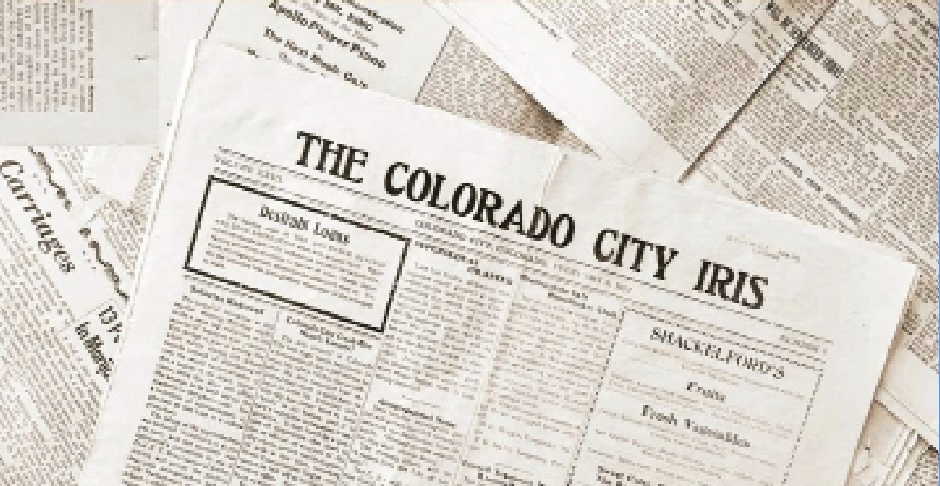Small local newspapers were abundant in 19th and early 20th century Colorado. Every town, however small, boasted its own weekly or semi-weekly. News, gossip, cheerful advertisers and compelling stories kept them afloat.
Few survive. Many, including the Colorado City Iris, the Colorado City Argus (1909-1921), the El Paso County Democrat (1906-1921) and the Colorado Springs Independent (1922-1953 — not related to the present-day publication) focused wholly or partially on Colorado City and the Westside. The newspapers have long since disintegrated, but many pages are available on microfilm through the Pikes Peak Library District.
The Colorado City Iris began publication in 1889 and gave up the ghost in 1917, when Colorado Springs annexed its smaller neighbor. It was fun, feisty and opinionated — and apparently always ready for a fight.
Consider the front page of the Aug. 12, 1891, issue. Thanks to railroads, saloons and glass makers, the little city’s economy was strong. Bob Womack had yet to find gold on the backside of Pikes Peak and Cripple Creek didn’t exist, so there wasn’t much news to report.
That didn’t bother Epperson & Cunningham, the Iris’ co-publishers, who filled the front page with jokes, advertisements and deliberately dubious news items. Here’s a sampling:
“Hope Beyond: An exchange announces, on the death of a lady, that ‘she lived fifty years with her husband and died in confident hope of a better life.’”
And here’s one that must have thrilled gardeners, farmers and grocers:
“The latest discovery in the vegetable kingdom is made by Dr. B.G. Culver of this city in the propagation of a ‘vine which he christened potamato, that will grow potatoes in the usual fashion and bear tomatoes, as does the tomato plant, at the top.’ Dr. Culver has spent twenty-one years in experimenting, so that next year he will be able to distribute seed ‘in limited quantity.’” (from the Atchison, Kansas, Champion)
The upstart Iris was ready to fight with the Colorado Springs Gazette, even after the Gazette had praised it.
“The new publishers of the Colorado City Iris, have materially changed the appearance of the paper, and it’s now one of the newest and newsiest in the County.” — Gazette.
It was fun, feisty and opinionated
“Thanks, gentlemen. Now if you will admit that the Colorado City glass factory is an institution of Colorado City, all will be peace between us, otherwise we will make reprisal by claiming the Civill & White ice plant and what few other manufactories you have, which will leave you poor indeed,” the Iris replied.
The Western Enterprise, a full-sheet publication created by and for the Pikes Peak region’s African-American citizens, featured an advertising-free front page with local, national and international news. A modern reader might be reminded of the New York Times or the Wall Street Journal. Here are two stories on the front page on Jan. 6, 1900:
“A team of surveyors will be put to work in South Platte Canon next week by the Colorado & Southern to run lines for the continuation of the new Cripple Creek cut-off from its present terminus to Horse Creek, ten miles. The survey will be made for a broad-gauge road.”
Most international stories were of general interest, but some may have particularly resonated with the African-American community.

“Manila, Jan. 3: A naval officer who has arrived here from Guam brings a proclamation by Captain Leary, naval governor of that island, decreeing the absolute prohibition and total abolition of slavery or peonage. (Leary declared) that the Spanish system of peonage is a violation of the privileges guaranteed by the American constitution.”
And what about the Iris’s nemesis, the weekly Gazette? Its front-page format was very much like that of the Iris — ads, short pieces and a couple of longer ones. The two 1891 issues have one thing in common: a prominent ad from Frank Dutton, a Colorado Springs grocer located at 19 N. Tejon St.. The prices!
Here are three of 22 advertised:
“Three and one-half pounds Mocho and Java coffee for $1.00”
“75 cent pure chocolate creams assorted 35 cents per pound.”
“Spratt’s dog food 9 cents a pound.”
At the bottom of the ad, a simple suggestion: “Read our ads for your own good.”
Good advice — but it would appear that we’re 132 years too late for the bargains … maybe next year?
